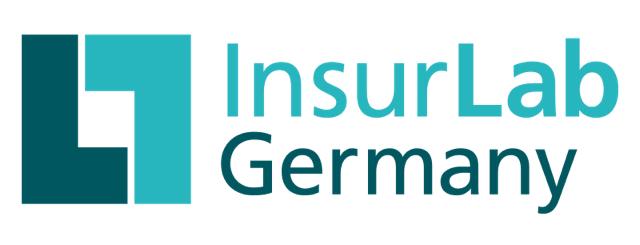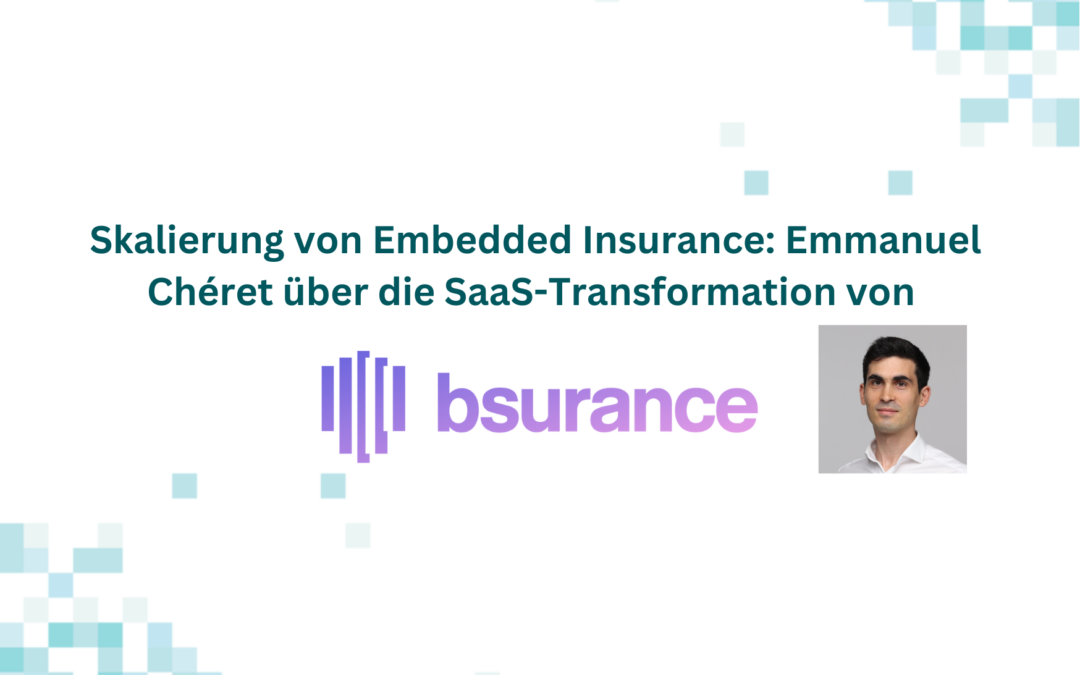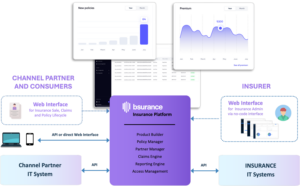The Vienna-based Insurtech bsurance has recently revisited its strategy and upgraded its business model with the launch of a SaaS vertical offering a no-code insurance platform specialized in embedded insurance. Following a leadership transition, the company is now focusing on scalability, technology partnerships, and sustainable business models. As part of this shift, a new management team has taken over, with Emmanuel Chéret as the new CEO, supported by a leadership team that aims to drive the company’s next phase of growth .
.
In this interview, Emmanuel Chéret shares insights on bsurance’s transformation, the evolution of Embedded Insurance, and the opportunities this shift creates for the broader industry.
Emmanuel, you took over as CEO of bsurance during an exciting phase of transformation. What is your background and what motivated you to take on this challenge?
I was introduced to bsurance by Andreas Nemeth from UNIQA Ventures, a leading venture capital firm based in Vienna and specialized in insurtech in Europe. They were back then invested in an Insurtech where I was the General Manager of a specialized MGA, and they were looking for somebody who could bring experience across insurance and digital to lead the transformation at bsurance. My own background is rooted in startups, with the last five years at the intersection of insurance and digital transformation. There was a good fit, and we were immediately aligned with Andreas on the vision: embedded insurance is growing but still far under potential in Europe, and the technology of bsurance has the potential to significantly accelerate its development.
What I found particularly exciting is that unlike most software, the bsurance platform is born from experience, almost as a by-product. Over 8 years, bsurance has conducted more than 30 projects in 10 countries in Europe as a managing general agent (MGA) specialized in embedded insurance. With each project, bsurance faced new challenges and had to find a technological solution, progressively building its own components, each time incorporating new learnings and capabilities.
The result of this is a very cleverly designed insurance distribution platform that packs years of experience, practice and learnings into an out-of-the-box solution. Whether you’re a business team slowed down by legacy IT in a traditional insurance or starting a new business in the field of embedded insurance, having access to such a solution is a game changer. I found the vision to bring this product into the hands of a wider audience very compelling and decided to jump in.
bsurance specializes in Embedded Insurance. How do you see this field evolving?
Embedded insurance in Europe is accelerating rapidly, and this isn’t going to slow down any time soon. New companies are entering the space, and traditional players realize the pressing need to evolve their business models and adapt.
It is great to see telco, banks, or retail business showing real ambition in embedded insurance sales and thriving to deliver modern, seamless digital experience to consumers. I think the snowball effect is already compounding. As companies witness exciting, successful projects around them, risk aversion is replaced by the fear of missing out and you can currently sense a real acceleration. I see it firsthand at bsurance, where we regularly see former relations returning to us on projects that had been explored sometimes several years ago, this time with a much firmer commitment.
The key question for insurance companies is deciding which role they want to play in this evolving landscape. It’s undoubtedly an existential challenge, requiring a shift in both culture and technology. However, it also presents massive opportunities. With their existing assets of reputation, brand, local presence, insurance companies are well-positioned to be at the forefront and should not fear to play a leading role in driving change, especially when solution exist to test and learn at a minimal cost.
bsurance has recently launched a new platform solution. What were the main drivers behind this decision, and how has it impacted the company both internally and externally?
In the fast-moving landscape of embedded insurance - with both traditional insurance companies facing the need to re-invent themselves and new entrants - the need for an out-of-the-box solution that enables fast deployment while minimizing risk is clear. Whether it is a risk carrier burdened by legacy IT, a telco considering launching a fully embedded insurance offerings, or a new entrant looking for a quick start, the need for a platform to build on is there. We recognized the opportunity and the fact that we had a distinct competitive advantage to serve this growing need and decided to develop the SaaS offering into a new pilar of our business model.
In practice, we organized a lean, very capable team and doubled down on software. We transformed our initial product into a fully productized SaaS solution - the bsurance platform. In parallel, we updated our branding and positioning to reflect this shift and the increased importance of technology in our model, and started going to market, mainly in Austria at first, leveraging our direct network to generate traction.
The results so far have been highly promising. A major milestone for us is the launch of UNIQA’s embedded insurance platform. Bsurance was selected as the preferred supplier against nine other international companies in a competitive process, ranking #1 in all criteria - technical, functional, and cost-effectiveness - a significant validation of our platform’s maturity, uniqueness and relevance.
Beyond that, the market is very responsive to our value proposition, and we are currently working on several exciting and diverse cases with insurance companies, telco’s, banks and brokers/agents. While the priority of the last 6-12 months was to build and organize, this year it is all about spending more time with our potential clients and further developing our platform. The external change that excites me the most is seeing what becomes possible once our platform is in the hands of business teams. In a live session with a client, we configured and launched our first product live in literally 20 minutes end-to-end. That’s unlike anything they had seen before. Suddenly, you hear a bunch of ideas for products or business lines that you could address: the amazing thing is when you realize that people start thinking differently, once they realize what is possible
Technology is indeed a key driver for embedded insurance. What do you see as the key challenges and opportunities in leveraging technological advancements to increase its adoption?
The challenge of legacy IT remains a significant barrier for many insurance companies, particularly when it comes to embedded insurance. These systems were not designed for the rapid adaptation and scalability that embedded insurance demands. The issue is further compounded by a lack of standardization, especially when operating across multiple countries or considering post-merger scenarios, where each entity, country, and business line may have its own bespoke solution.
Digital transformation is certainly on the way, but the truth is it’s never “done” it’s an ongoing process with shifting priorities. I find that embedded insurance, often categorized as “affinity,” is particularly left behind because it is typically seen as a secondary concern in the process of large-scale transformation, which focuses on existing core processes that currently drive the volumes.
Meanwhile, business teams require more immediate solutions. That’s why I’m quite convinced – and that’s also what I observe - that insurance carriers will increasingly adopt lightweight, standalone tech solutions like bsurance. These will offer greater agility, enabling them to more effectively deliver, manage, and scale digital (embedded) insurance products.
bsurance strongly relies on partnerships with players from different sectors. What are the most important factors for successful collaborations?
Strong partnerships are a key part of our strategy. Collaboration is essential to how we operate, and our model has largely been shaped by the deep collaboration and insights we’ve gained through our partnership.
A lot of clients such as insurance companies, banks or generally established corporates, are risk-averse, and for good reason. At bsurance, we believe in reducing the cost of experimentation, being open to learning, accepting failure as part of the process, and always planning for optionality and reversibility. This philosophy is reflected in everything we do - our approach is designed with minimal setup costs and full access to data to ensure reversibility when needed.
Developing a true "test and learn" mindset is crucial, but it can be especially challenging for insurance companies, which are, by nature, extremely cautious. Embracing this mindset is a journey that starts with creating impact today, learning from it, and then integrating those lessons deeper into the business. The key is to stay focused on business results first while maintaining an open mind.
Which companies should start exploring Embedded Insurance now – and how can bsurance support them?
Almost any consumer business can strengthen its model by integrating embedded insurance. At bsurance, we provide a comprehensive, one-stop shop solution. As an MGA, we help businesses find the right insurance products and seamlessly integrate them into their point of sale. As a software provider, we enable companies to fully own the value chain and develop their own insurance capabilities.
Two areas excite me the most in this space. The first is helping established risk carriers build their own embedded insurance offerings and capabilities directly. As I mentioned earlier, these companies need to take a strategic position, and there is a significant opportunity to create strong local players by leveraging their existing strengths and supercharging it with our technology. That’s exactly what we started doing, and I think these projects will have a significant impact.
The second exciting trend is the rise of businesses that are making digital insurance sales a core part of their business models - such as telecom companies, banks, and utilities. By embedding insurance processes directly into their consumer apps, they are transforming the industry. This shift is not just about distribution; it’s about creating entirely new customer experiences, making insurance more accessible, relevant, and affordable. It’s a game-changer, and I can’t wait to see how it continues to evolve.
Dear Emmanuel, thank you very much for the interview - we wish you continued success in any case!




